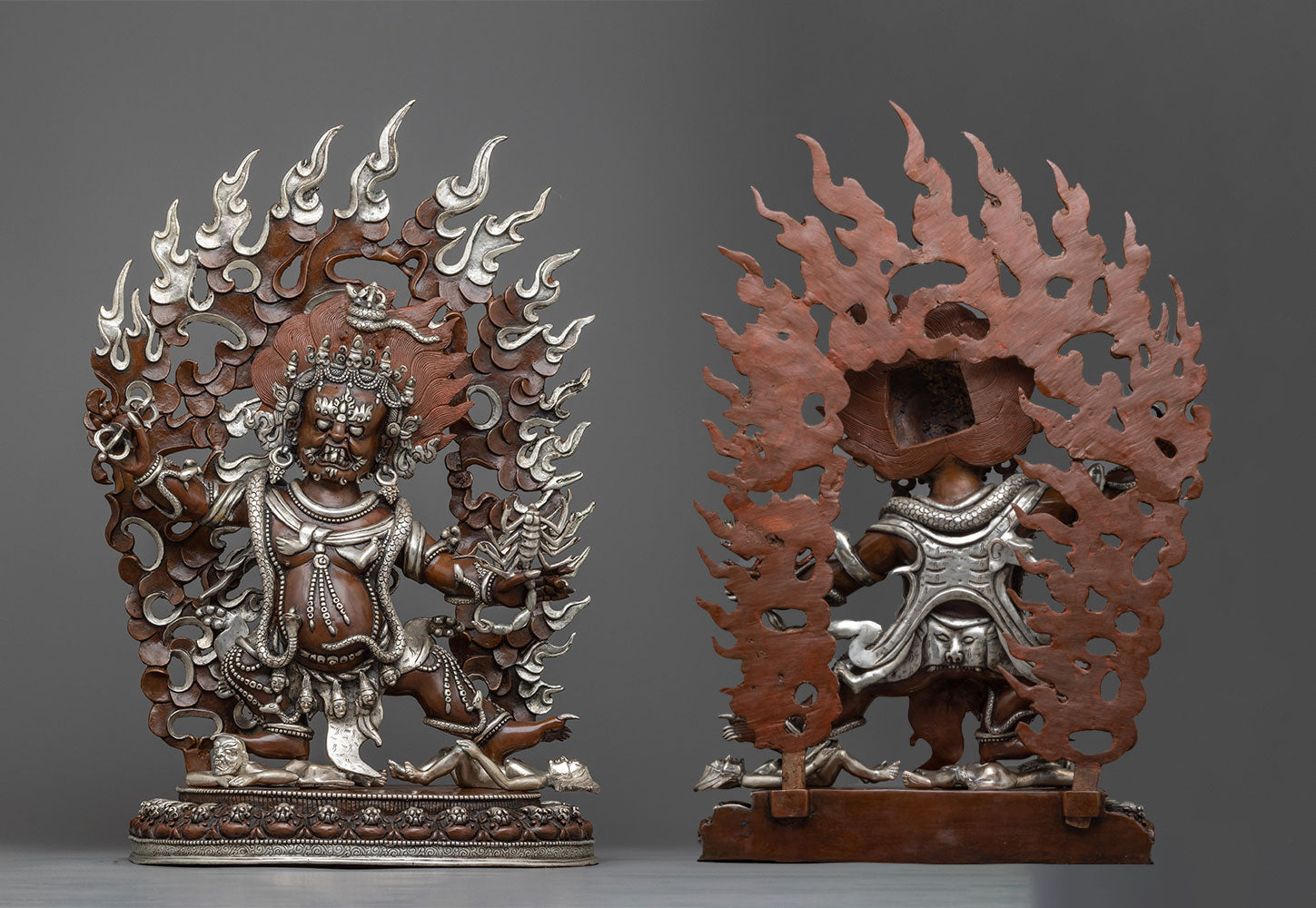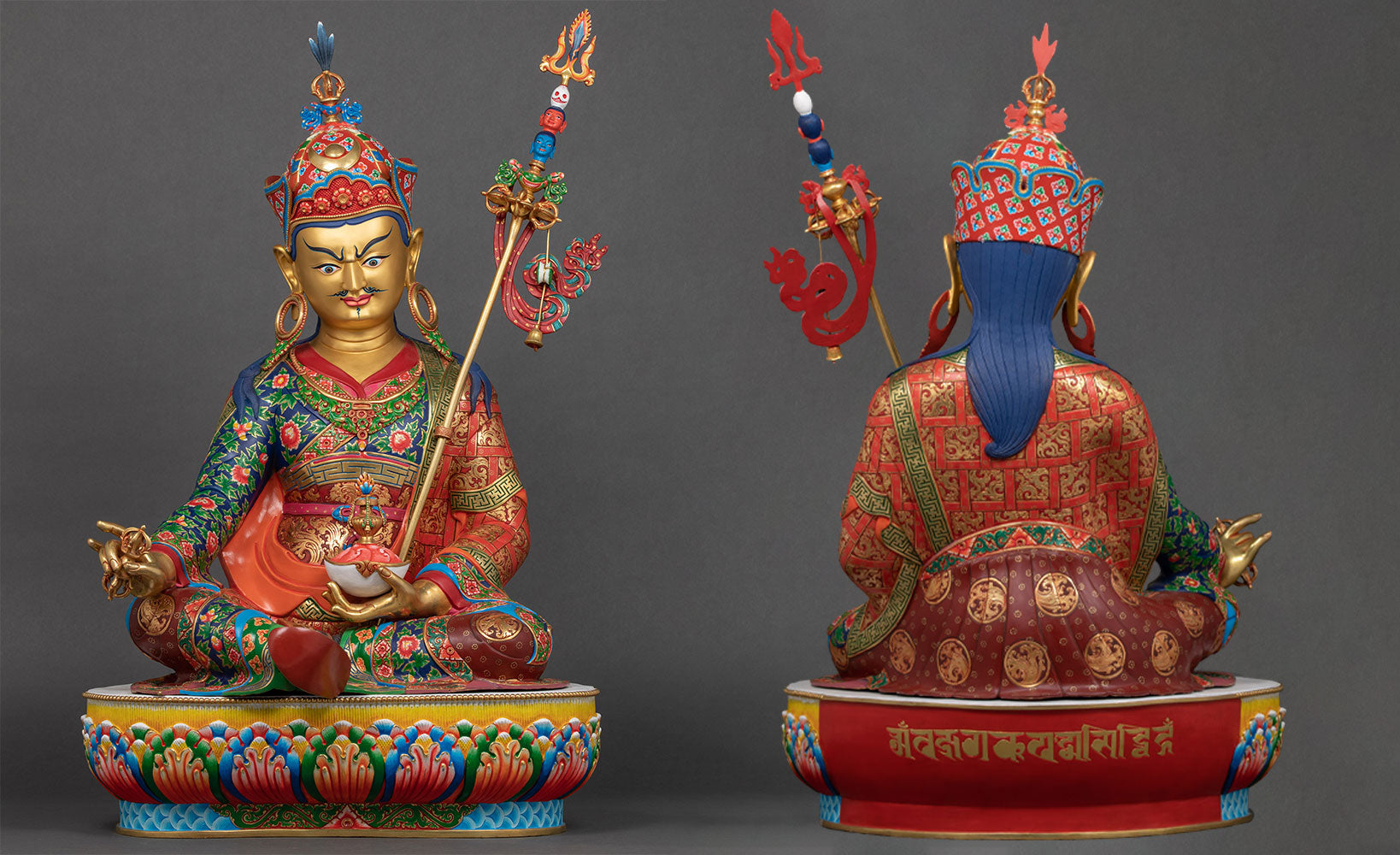Guru Dragpo: The Wrathful Protector in Tibetan Buddhism
Guru Dragpo, a key figure in Tibetan Buddhism, represents the fierce aspect of Padmasambhava, also recognized as Guru Rinpoche—a revered protector deity. This in-depth article explores Guru Dragpo's roots, importance, iconography, and associated practices, providing a comprehensive understanding of this powerful manifestation.
Key Takeaways
- Guru Dragpo is a wrathful form of Padmasambhava.
- Integral to Tibetan Buddhist practices, especially in the Nyingma tradition.
- His iconography is symbolic, representing profound spiritual teachings.
- Methods associated with Guru Dragpo are used for overcoming obstacles and protection.
Within the intricate tapestry of Tibetan Buddhism, Guru Dragpo emerges as a formidable embodiment of the fierce facet of Padmasambhava. Contrary to malevolence, this deity is a potent spiritual guardian, pivotal for navigating spiritual and worldly challenges.
Origins and Historical Context
Click here to view Guru Dragpo Statue
Guru Dragpo finds his roots in the tantric traditions of Tibetan Buddhism, with a significant emphasis on the Nyingma school. Representing the transformation of Padmasambhava, he plays a central role in introducing Buddhism to Tibet.
Iconography of Guru Dragpo in Tibetan Buddhism:
The portrayal of Guru Dragpo in Tibetan Buddhism is visually striking and rich in profound symbolism. Each facet of his depiction holds deep spiritual significance, mirroring Buddhism's intricate and profound teachings.
Detailed Physical Depiction Guru Dragpo's depiction is intentionally fearsome and robust, designed to convey his role as a protector and destroyer of obstacles.
Dark Blue Body: The deep blue color of Guru Dragpo's body carries profound symbolism, representing the vastness of space and the depths of wisdom. It serves as a visual metaphor for the boundless nature of his power, signifying his ability to encompass all phenomena.
Multiple Arms: Guru Dragpo is often depicted with multiple arms, each grasping different symbolic objects. These arms illustrate his capacity to concurrently engage in numerous protective and transformative activities. The diversity of components signifies his omnipresence and omnipotence within the spiritual realm.
Flames: Guru Dragpo is commonly portrayed engulfed in fire, symbolizing not destruction but purification. These flames represent the transformation of ignorance into wisdom, indicating the burning away of impurities and obstacles on the path to enlightenment.
Fierce Expression: His wrathful expression, featuring bared fangs and a scowling countenance, does not denote malevolence. Instead, it symbolizes fierce determination, signifying the power to overcome opposing forces and cut through delusions on the journey to enlightenment.
Symbols and Attributes
Each symbol and attribute in Guru Dragpo's iconography has a specific spiritual significance.
Vajra (Thunderbolt): In one of Guru Dragpo's hands, the vajra, or thunderbolt, serves as a symbol of indestructible truth, embodying the unwavering power of enlightenment. It signifies reality's absolute and unchangeable nature, encapsulating the essence of Buddhist teachings.
Phurba (Ritual Dagger): Another common attribute is the phurba, a ritual dagger symbolizing the piercing of ignorance, ego-delusion, and obstacles to enlightenment. The phurba is a tool for subduing demonic forces and dispelling negative energies.
Skull Cup: Guru Dragpo is often depicted holding a skull cup, symbolizing the transformative journey from death to life. It represents the impermanence of all things and can also be seen as a metaphor for cultivating wisdom through understanding impermanence.
Snakes and Skulls: Adorned with garlands of snakes and skulls, Guru Dragpo symbolizes the triumph over death and the cycles of samsara—the continuous loop of birth, life, death, and rebirth. These elements underscore the theme of conquering mortality and transcending the cyclic nature of existence.
Seated Posture and Pedestal: Lotus Throne: Guru Dragpo is commonly portrayed sitting on a lotus throne, symbolizing his untainted and enlightened nature, unmarred by the impurities of the mundane world.
Mountains or Cremation Grounds: The backdrop often includes mountains or cremation grounds, symbolizing the transcendence of worldly attachments and the impermanence inherent in life.
Integration with Surroundings: Mandala: Occasionally, Guru Dragpo is situated within a mandala, signifying the spiritual and cosmic order of the universe. This incorporation emphasizes the deity's role within the broader framework of Buddhist cosmology and practice.
The iconography of Guru Dragpo is a rich tapestry of symbols and meanings. Each aspect of his depiction is a teaching, representing deep Tibetan Buddhist concepts. Understanding these symbols can enhance one's appreciation of Guru Dragpo's role as a protector and guide on the spiritual path, embodying enlightened beings' wrathful yet compassionate nature.
Connection to Padmasambhava
Click here to view our Guru Rinpoche Statue
Padmasambhava, also known as Guru Rinpoche, holds a foundational position in Tibetan Buddhism. In the form of Guru Dragpo, his wrathful incarnation showcases immense power in overcoming spiritual obstacles, embodying a fierce yet protective energy.
Central Role in Tibetan Buddhist Practice:
Guru Dragpo plays a pivotal role in Tibetan Buddhist practices, particularly within the Nyingma tradition, where he is esteemed for his exceptional ability to dispel obstacles and safeguard the Dharma.
Significance in Spiritual Practices
Guru Dragpo is invoked for his protective prowess in clearing spiritual and temporal obstacles within Tibetan Buddhism. Practitioners consider his presence essential for ensuring a secure journey on the spiritual path.
Crucial in Tantric Practices
Guru Dragpo's formidable form holds paramount importance in tantric rituals. These practices aim to harness his fierce energy to subdue hostile forces, transmuting them into positive energies that facilitate the practitioner's spiritual progress.
Practices and Rituals Incorporation into Tibetan Buddhist Practices: Guru Dragpo is prominent in diverse Buddhist practices and rituals, explicitly emphasizing the Nyingma tradition.
Meditation and Visualization Techniques
Meditation practices featuring Guru Dragpo often entail intricate visualizations of his formidable form. This immersive process assists practitioners in addressing and surmounting internal and external obstacles on their spiritual journey.
Central Role in Protective Rituals
Guru Dragpo plays a pivotal role in protective rituals that repel negative influences. These rituals establish an environment conducive to spiritual growth, emphasizing the deity's significance in safeguarding practitioners from adverse forces.
Guru Dragpo, as a wrathful yet protective deity, embodies the transformative power of Tibetan Buddhism. His role extends beyond historical and cultural confines, offering a path for overcoming obstacles and achieving spiritual growth.




